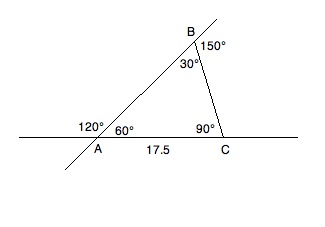All High School Math Resources
Example Questions
Example Question #2 : How To Find The Length Of The Hypotenuse Of A Right Triangle : Pythagorean Theorem
Square 






Quantity A:
Quantity B: The distance between points 
The two quantities are equal.
Quantity A is greater.
The relationship cannot be determined from the information provided.
Quantity B is greater.
The two quantities are equal.
To find the distance between points 



Example Question #511 : Psat Mathematics
Justin travels 

This is solving for the hypotenuse of a triangle. Using the Pythagorean Theorem, which says that 

Example Question #52 : How To Find The Length Of The Hypotenuse Of A Right Triangle : Pythagorean Theorem
Susie walks north from her house to a park that is 30 meters away. Once she arrives at the park, she turns and walks west for 80 meters to a bench to feed some pigeons. She then walks north for another 30 meters to a concession stand. If Susie returns home in a straight line from the concession stand, how far will she walk from the concession stand to her house, in meters?
70
50
25
200
100
100
Susie walks 30 meters north, then 80 meters west, then 30 meters north again. Thus, she walks 60 meters north and 80 meters west. These two directions are 90 degrees away from one another.
At this point, construct a right triangle with one leg that measures 60 meters and a second leg that is 80 meters.
You can save time by using the 3:4:5 common triangle. 60 and 80 are 


We can solve for the length of the missing hypotenuse by applying the Pythagorean theorem:
Substitute the following known values into the formula and solve for the missing hypotenuse: side 
Susie will walk 100 meters to reach her house.
Example Question #512 : Psat Mathematics
The lengths of the sides of a triangle are consecutive odd numbers and the triangle's perimeter is 57 centimeters. What is the length, in centimeters, of its longest side?
19
25
23
17
21
21
First, define the sides of the triangle. Because the side lengths are consecutive odd numbers, if we define the shortest side will be as 


Substitute in the known values and variables.
Subtract 6 from both sides of the equation.
Divide both sides of the equation by 3.
Solve.
This is not the answer; we need to find the length of the longest side, or 
Substitute in the calculated value for 
The longest side of the triangle is 21 centimeters long.
Example Question #52 : How To Find The Length Of The Hypotenuse Of A Right Triangle : Pythagorean Theorem
Each of the following answer choices lists the side lengths of a different triangle. Which of these triangles does not have a right angle?





Example Question #1 : How To Find The Perimeter Of A Right Triangle
What is the perimeter of a triangle with side lengths of 5, 12, and 13?
To find the perimeter of a triangle you must add all of the side lengths together.
In this case our equation would look like
Add the numbers together to get the answer 
Example Question #11 : Triangles
Three points in the xy-coordinate system form a triangle.
The points are 
What is the perimeter of the triangle?
Drawing points gives sides of a right triangle of 4, 5, and an unknown hypotenuse.
Using the pythagorean theorem we find that the hypotenuse is 
Example Question #171 : Triangles
Find the perimeter of the following triangle:

The formula for the perimeter of a right triangle is:
where 
Use the formulas for a a 


Our 
Plugging in our values, we get:
Example Question #84 : Right Triangles
Find the perimeter of the following right triangle:

The formula for the perimeter of a right triangle is:
where 
Use the formulas for a 

Our 
Plugging in our values, we get:
Example Question #1001 : High School Math

Based on the information given above, what is the perimeter of triangle ABC?

Consult the diagram above while reading the solution. Because of what we know about supplementary angles, we can fill in the inner values of the triangle. Angles A and B can be found by the following reductions:
A + 120 = 180; A = 60
B + 150 = 180; B = 30
Since we know A + B + C = 180 and have the values of A and B, we know:
60 + 30 + C = 180; C = 90
This gives us a 30:60:90 triangle. Now, since 17.5 is across from the 30° angle, we know that the other two sides will have to be √3 and 2 times 17.5; therefore, our perimeter will be as follows:
All High School Math Resources


































































